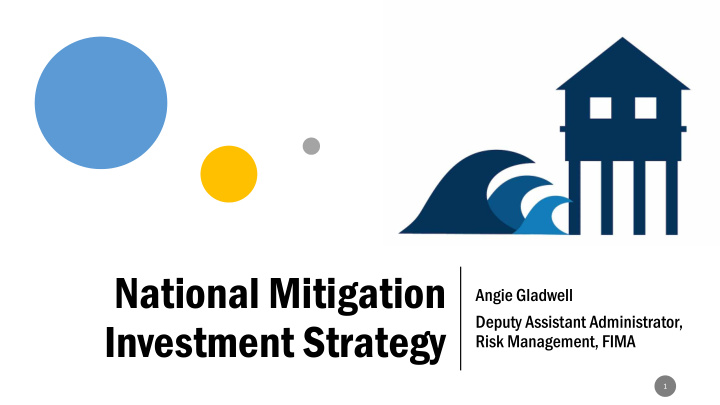



National Mitigation Angie Gladwell Deputy Assistant Administrator, Investment Strategy Risk Management, FIMA 1
How Did We Get Here? Cal all f for St Strat ategy Draft R Dr Rel elea eased Fin inal al St Strat ategy MitFLG issues draft Final Investment Lack of coordinated Investment Strategy Strategy to be mitigation investments for Public Comment released today ay, following Hurricane in 2018 August 13, 2019 Sandy The Investment Strategy establishes a means to identify, prioritize, and implement federal investments in disaster resilience that will limit the nation’s fiscal exposure to disaster losses. 2
The Mitigation Framework Leadership Group FEDE DERAL RAL POLICY CY COORDI RDINATING NG STRUCT CTURE RE WITH STATE, LOCAL CAL, TRI RIBAL AL, AN AND TERRI RRITORI RIAL AL REPRE RESENT NTATI TION 3
Investment Strategy Intent 2. Catalyze private and non-profit sector mitigation investments and innovation across the whole community 1. Improve collaboration between the federal government and communities, Improve the respecting local expertise in coordination mitigation investing and effectiveness of 3. Make data- and risk-informed mitigation decisions that include long-term investments. costs and risks Mitigation investments are defined as risk management actions taken to avoid, reduce, or transfer risks from natural hazards, including severe weather. 4
Success Depends on Collective Action: • Find ways to link, leverage, and align current and on-going investments to meet these goals. • Look for projects and efforts that can create benefits to multiple stakeholders and funders. • Bring in new partners to provide new ways of looking at the problem, or proposed solutions. • Find ways to share efforts that are having significant impacts across large network. • Use the research community to help answer tough questions. • Use open-source data formats to facilitate information sharing. 5
Investment Strategy Goals Show H w How w Mitigat ation I on Inve vestment nts Reduc uce R Risk: Objective: Provide stakeholders with a foundational understanding of how mitigation investment protects what they value. Coordinat nate M Mitigat ation I on Inve vestment nts to Reduc uce R Risk: Objective: Foster better understanding of risks (quality risk data) to support investment decisions, Goal 2 assure alignment of programs and incentives toward risk reduction goals, and reduce complexity in access to investment funds. Make M Mitigat ation on Inve vestment nt S Stand ndar ard P Prac actice: Objective: Assure that national stakeholders are participating in mitigation activities, especially decisions Goal 3 to enhance building codes and infrastructure (lifeline) standards and the use of financial products that link to mitigation (insurance, cat bonds, resilience bonds). 6
Show How Mitigation Investments Reduce Risk Recom ommend ndati ation on 1.1 – Make Mitigation Investments Relevant Recom ommend ndati ation on 1.2 – Increase Mitigation Investment by Building the Capacity of Communities to Address Their Risks Recom ommend ndati ation on 1.3 – Use Common Measures to Aid Decision-Making for Mitigation Investment 7
Making Mitigation Relevant: How Does Mitigation Investment Reduce Your Risk? • Makes homes and neighborhoods safer • Strengthens ability for communities to restore lifelines quickly following a disaster (for example, energy; food, water, and sheltering; health and medical; safety and security; communications; transportation; and hazardous materials) • Protects jobs and personal finances • Prevents injury and loss of life • Reduces suffering after a disaster; and • Protects areas important to a community 8
Coordinate Mitigation Investments to Reduce Risk Goal 2 Recom ommend ndati ation on 2.1 – Make Risk Information More Available and Easier to Use Recom ommend ndati ation on 2.2 – Align Program Requirements and Incentives Recom ommend ndati ation on 2.3 – Make Funding for Mitigation Investment Easier to Access 9
How Can You Coordinate Mitigation Investments to Goal 2 Reduce Risk? • Share and utilize consistent risk information • Integrate the consideration of current and future risk into planning efforts • Align risk priorities across multiple organizations and sectors • Use and align incentives towards common goals • Leverage public/private partnerships • Simplify applications/processes for funding 10
Make Mitigation Investment Standard Practice Goal 3 • Recom ommend ndati ation on 3.1 – Encourage Communities to Adopt and Enforce Up-to-Date Building Codes • Recom ommend ndati ation on 3.2 – Strengthen Critical Infrastructure and Lifelines • Recom ommend ndati ation on 3.3 – Use and Expand Financial Products and Approaches to Reduce and Transfer Risk 11
What Does it Mean to Make Mitigation Goal 3 Investment Standard Practice? • Whole communities are safe, not only specific parts of the communities (businesses, homes, infrastructure) • Every current and future investment considers mitigation, especially buildings and infrastructure • Building codes and standards are up to date • Insurance, grants, tax incentives, bond ratings, and other financial tools drive mitigation investment 12
How Will We Succeed? Less Disaster Whole Federal Government Suffering Community and vital Nonfederal Participation Partners 13
For More Information • Learn more: https://www.fema.gov/national-mitigation- investment-strategy • Email questions and comments to FEMA- NMIS@fema.dhs.gov 14
15
Recommend
More recommend